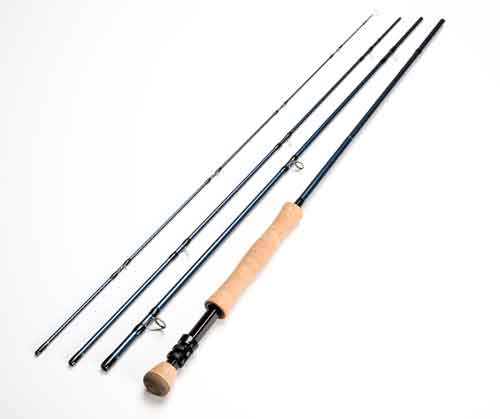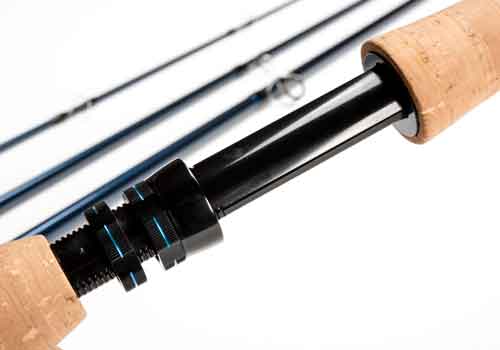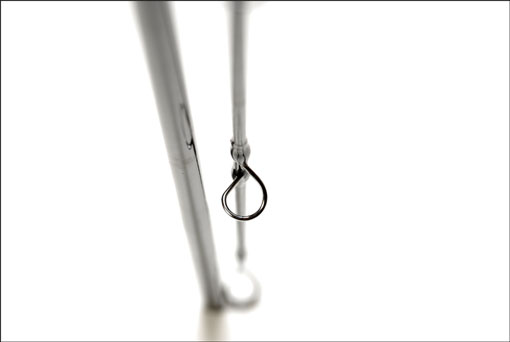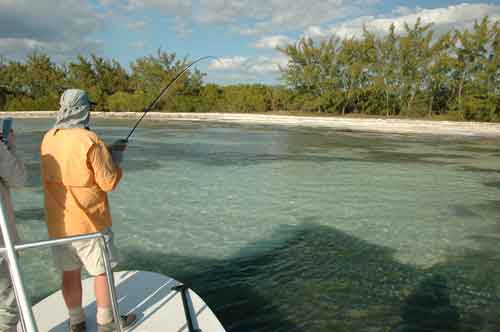The Mackenzie FX1 stable of rods uses graphene – the ultra-thin, strong and ultra-light carbon composite that has already made its mark in both Formula One racing and tennis rackets (for instance, Novak Djokovic uses rackets made of this material). In the world of sports today anything that can add an edge of stronger, lighter and faster is always going to attract interest of designers and users, and having one material that can cover all three bases will turn heads when it comes to a fly rod.
Scott Mackenzie has already paved the way with graphene rods with his double-handed salmon rods and now comes the range of single-handed saltwater models. The single-handed FX1’s were built using Scott’s designs along with the expertise of Professor Gary Savage, who as one of the world’s leading experts in carbon and composites, became a World Champion Team member in Formula One racing.
The black anodised reel seat, the twin up-locking nuts highlighted with metallic blue complement the metallic dark blue blank well and make the rod look like it means business. Large titanium snakes are all about lightness, distance and smooth shooting as are the twin stripper guides on the second section of the blank. The cork on the handle is good quality with a modicum of filling.
Lightness, balance and feel at the handle are apparent when you hold this rod and those assets shouldn’t be under-estimated. When you think about saltwater flats fishing, much of the time is spent just holding the rod awaiting a call to action. I’ve noticed that when I’m on the front of a skiff I barely hold the rod, it generally just balances there on my second and third finger of my right hand. Whenever you are called to make a cast, the last thing you want to be is tensioned like an uncoiled spring and gripping the handle like it was a ‘in case of emergency – break glass’ hammer.
So, when it comes to making that cast, how does the FX1 fare?
I found that the FX1 has an inherent stiffness to the blank, thus loading and casting distances with a #9 line were relatively easy once the head was aerialised, with the blank appearing to have extra power in reserve, so hauling can bring about more distance and power if required (I noticed Magnus Angus picked up on the same properties when he reviewed the #6 [April issue]). Accuracy was something that came almost as second nature, the track of the rod (and its recovery) being incredibly stable (one of the attributes of graphene, and probably also due to that stiffness in the tip). I used this rod mainly with a shortish, 6-7ft leader, culminating in a thin, 55lb BS shock leader, designed for baby tarpon and snook. Fishing a rod with the power of a nine-weight and a short leader means that the fly (in my case generally an EP-style Sardine pattern) can ‘kick’ at the end of the shoot, especially if it is over-powered, making the resultant presentation a little awkward and ‘clumsy’. However, I found that on this outfit, with this set-up, fly accuracy didn’t require too much thought. It can turnover big flies.
This was demonstrated to me when I was fishing with Rick Lilley, as we worked the skiff down one of Zapata’s beaches. The exciting thing about these Cuban beaches is that you might encounter big bonefish, but you also need to keep an eye on the beach edge, as nice snook patrol here, too. I spotted a snook working along the edge of some weed, but Rick only had his bonefish rod to hand. “Here, try this”, I said handing him my FX1 outfit. By this time, the snook had come to rest in a tiny, two-foot opening between the weeds, right at the beach’s edge. This fish was definitely on the prowl for baitfish, and if Rick could land the fly inside that gap from a distance of 20 yards plus, then it was a likely taker. Rick had never picked up the FX1 before, and he’d certainly never cast it. But, within two false casts the line shot towards the target, the leader turned over perfectly straight, and the Sardine landed right in the gap. The snook simply HAD to take it. One pull, and it had locked on.
Snook are acrobatic and tough fighters with explosive runs for cover which have to be stopped. Again, the FX1 has the backbone to be able to cope easily with such aggressive, powerful fighters – all in all, just what you need from a saltwater nine-weight. I find that I’m using a nine-weight more and more in saltwater these days – much more pleasurable experience that a #10. This one’s well worth considering for snook, baby tarpon, big bonefish and other saltwater predators, and it would also double-up as a very good pike rod.







